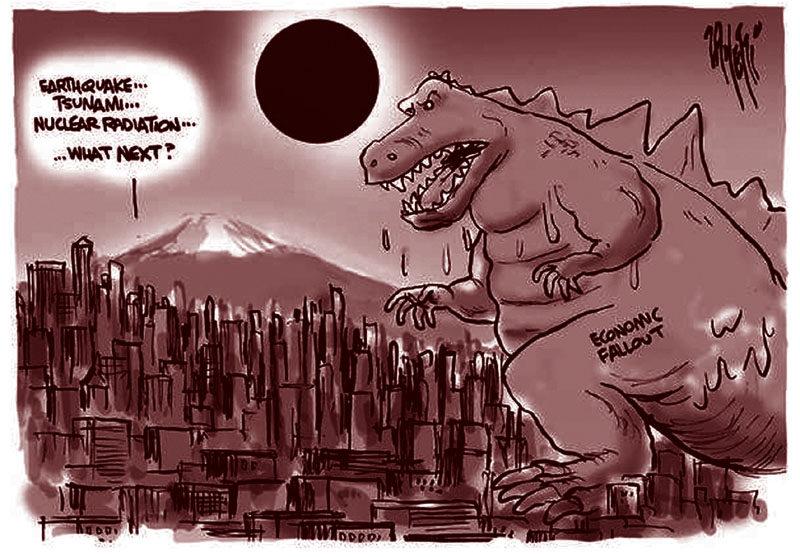日本地震一周年:毁灭与重生

On March 11, 2011, a magnitude 9.0 earthquake occurred off the Pacific coast of Tohoku in Japan.1
The 2011 Tohoku-Oki earthquake was the most powerful known earthquake ever to have hit Japan, and it triggered a powerful tsunami and sparked a nuclear crisis and health scare.2
NASA researchers later discovered that the destructive tsunami generated by the earthquake was a long-hypothesized“merging tsunami” that doubled in intensity over rugged ocean ridges, amplifying its destructive power before reaching shore.3
Satellites captured not just one wave front4 that day, but at least two, which merged to form a single doublehigh wave far out at sea—one capable of traveling long distances without losing its power.
At the one year anniversary of the Great East Japan Earthquake, together with international and local support, Japan is slowly rebuilding its towns, schools, fisheries and… hearts, through acts of resilience and sheer courage.5
Resilience: Sunflowers to decontaminate toxic soil6
The Japan earthquake and tsunami did more than just cause destruction to houses and roads; it caused severe structural damage to the Fukushima Dai-ichi nuclear power plant, knocking out its water cooling systems and melting the fuel rods inside several reactors, sparking explosions.7
In response, Japan raised the crisis level at the beleaguered plant from 5 to 7—the highest level on the International Atomic Energy Agencys scale for rating nuclear accidents.8 Food and water safety was also a concern, aside from the health implications of exposure to ionizing radiation.9
Shortly after the crisis, a group from the Japan Aerospace Exploration Agency (JAXA), led by Prof. Masamichi Yamashita, grew sunflowers around the nuclear plant to remove soil contamination of cesium.10
Radioactive cesium is similar to kalium, a commonly used fertilizer.11 If kalium is not present, sunflowers will absorb cesium instead. This move was similar to after the 1986 Chernobyl nuclear disaster, where sunflowers and rape blossoms were used to decontaminate soil in Ukraine.12
Starting with 300 kilograms of sunflower seeds, the group has sown sunflower seeds in the 30-kilometer region around the Fukushima plant. Aside from their task of removing radioactive cesium from the soil, the team also hoped that their sunflowers would become a symbol of recovery in the areas affected by the nuclear crisis.
Return to normalcy: The coastal town of Minami Sanriku13
Almost one year ago, Minami Sanriku was one of many coastal towns in the Northern Miyagi Prefecture that was devastated by the Tohoku-Oki earthquake and tsunami.14 Of its 17,666 residents, some 800 people died after 15-meter tsunami waves hit the coastal areas.
Today, the town is trying to get back its life, thanks to the help of the 50,000 volunteers and hundreds of residents who, together with government agencies, have worked day and night to clear damage caused by the disaster.
“The double disaster was a real tragedy for all of us,”said, Shuji Kounosu, a local resident. “But it has had an incredible positive effect on all of us as it revived the“koh” tradition (the tradition of helping each other), which was previously anchored in the Japanese traditional way of living.15 This has helped us so much to regain confidence in the future.”
And as of February, a group of 20 universities in Tokyo has pledged16 to launch the Minami Sanriku Volunteers Network for the Revival of Tohoku, which will help rebuild local industries, promote tourism, and provide farming assistance.
Fishermen who lost their fishing boats and homes have formed a cooperative in Minami Sanriku near Shizukawa fishing port, and Miyagi Governer Yoshihiro Murai has called for the establishment of a “special reconstruction zone for fisheries.”
“You can have all the walls you want to protect you but what makes a big difference are the community spirit and the solidarity17 between people,” Kounosu said.

1.magnitude:【地】震级。按震源放出的能量大小来分等级,释放能量越大,地震震级也越大。一般分为九级,2.5级以上的地震能被感知到,五级以上的地震就能造成破坏;Tohoku:(日本)东北部地区,覆盖了日本本州岛东北部的大片地域。
2. tsunami: 海啸;spark: 点燃,触发。
3. hypothesize: 基于假设的,假定的;merging tsunami: 合并海啸,是指两个或两个以上海啸波合并,在崎岖不平的洋脊隆起的影响下,毁灭性的力量进一步放大之后到达陆地的海啸;intensity: (电、热、光、波等的)强度,烈度;rugged: 高低不平的,多岩石的;amplify:放大(声音等),增强。
4. wave front: 【物】波前锋,波阵面。
5. Great East Japan Earthquake: 日本东北特大地震,也称作日本“3·11”特大地震;fishery: 渔场,渔业;resilience:(活力、精神等的)复原力,恢复力;sheer: 完全的,十足的。
6. decontaminate: 净化,给……去污;toxic: 有毒的,中毒的。
7. Fukushima Dai-ichi nuclear power plant: 福岛第一核电站;knock out: 使失去效能,使无用;fuel rod: 燃料棒;reactor: (核)反应堆。
8. beleaguered: 被包围的,被围攻的;International Atomic Energy Agency: 国际原子能机构,是一个致力推广和平使用核能的国际组织。此句中提到的核事件分级标准指的是国际核能事件分级表(International Nuclear Event Scale, INES),根据核电站事故对安全的影响作为分类,使传媒和公众更易了解事故的严重程度。七级是最高级别,用于指大量核污染泄漏到工厂以外,造成巨大健康和环境影响的核事故。
9. implication: 牵连,涉及;ionizing radiation: 电离辐射,对人体的危害性极大,阻延人体新陈代谢中旧坏细胞的死亡与停止分裂,从而导致癌症、不孕、基因突变等细胞异常情况。
10. Japan Aerospace Exploration Agency: 日本宇宙航空研究开发机构,负责日本航空太空开发政策;contamination: 污染;cesium: 铯,是一种用于制造真空器件、光电管等的重要材料的碱金属。
11.radioactive:放射性的,有辐射的;kalium:钾;fertilizer: 肥料。
12. 1986 Chernobyl nuclear disaster: 切尔诺贝利核电厂事故,是发生在乌克兰切尔诺贝利核电站的一起核事故,被普遍认为是历史上最严重的核电厂事故;rape blossom: 油菜花。
13. normalcy: 常态;Minami Sanriku: 南三陆町,是位于日本宫城县东北部临太平洋的一个小镇。
14. Miyagi Prefecture: 宫城县,是日本东北部的一个县,东邻太平洋;devastate:毁灭,毁坏。
15. revive: 复兴,复活;be anchored in:扎根于某种体系(或生活方式等)。
16. pledge: 发誓,保证。
17. solidarity: 团结。

